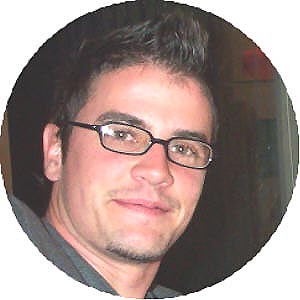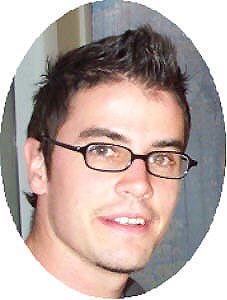 |
||||||||||||||||
| How did you get started with all of this, Josh? VSAC 2001 was your coming-out party, but there must have been much leading up to it. | ||||||||||||||||
| Well, my parents have always called me energetic - obsessively focused, with what they term explosive thinking capacity. Always reminding me how I didn't have to reinvent the wheel. (Laughs) Something in me can hear the sense in that, sure. Still, I feel compelled to investigate things as though I did have to - reinvent the wheel that is. | ||||||||||||||||
 |
||||||||||||||||
| Your dad was a systems-design engineer, wasn't he? | ||||||||||||||||
| He was also a dancer. And my mom Linda loves music. So from the beginning there were mechanical-electrical and artistic musical influences around. I soon became infamous for taking all sorts of things apart but never putting 'em back together (chuckles). My dad also was heavily into computers and had the very first Apple; which probably makes it 1971 or 72. Thereabouts. In school, a lot of kids were into music and played instruments. I didn't but wanted to be involved. So I started a recording studio, amassed quite a few components, many tube-based, and recorded my friends and school mates. | ||||||||||||||||
| That must have been good training, to learn about sound hands-on, translating what you heard live into adjustments on the mixing board. | ||||||||||||||||
| You bet. You have to become a soundsmith. You must wield the tools at your disposal. You're a cook looking for that one spice or combination of spices that will give you the flavor you're after. You begin to recognize aberrations in frequency response. You understand how to fix them. You recognize what makes up the timbres of specific instruments, how they're altered by the microphone placement. It's like going to culinary school and sampling every food, spice, vegetable, meat and exotic fruit imaginable. First you taste. Everything. Until it's become part of your palette, your spice collection. Then you experiment with how to assemble all these flavors. There are the main ones, in my case the output tubes and what family they're from. Then there are the more subtle ones - driver tubes, rectifiers, transformers, capacitors, circuits. You're looking for a well-blended whole that has depth, complexity and sophistication. Something that speaks to you emotionally, holds your attention, transports you to a different place. Very personal, this. I've done this tasting, extensively, with all manner of tubes. I know the basic flavor of every tube used in audio. I've also played with many that are far more exotic and rarely if ever used. I've tested different circuit topologies, transformer cores, power supplies, mutant versions. I know how they work, what they add or subtract, what their strengths and liabilities are. Then the trick is putting all of it together so that nothing stands out. Like a complex dish where no single spice is dominant or necessarily even recognizable, but where all the ingredients mesh, blend and augment each other. |
||||||||||||||||
| Was there a specific event that set you on the path, so to speak? | ||||||||||||||||
| My stepdad was heavily into music and always experimented with speaker building. He came from Los Alamos where they routinely sell off or discard exotic parts. He owned some Phase Linear amplifiers and read a lot of the magazines like Sound Practices and Valve Magazine. I got into those too and one day brought home an EL-34 push-pull HeathKit I had found on the Internet. Dave looked at this funky contraption, wrinkled his nose and walked off back into his room to work. I hooked it up and cued up the first tune. (Laughs) You should have seen how quickly he came back out of his room. My mom heard it, too. It was like Miles Davis was right there in the room with us. This got Dave to thinking. Somewhere around 1994 or 1995, he ordered up the Apollo monoblock kit from Ron Welborne and we built them up, he one channel, I the other. From there, I discovered the Japanese masters like Sukuma-San and read everything about tube design I could get my hands on. I always implemented what I read about with my own projects to understand what was talked about. At the time, I never worried about a final chassis. Everything was bread-boarded to allow easy access to change components on the fly. Then Dave bought a CAT preamp to augment his Apollos. I started to look at what was done in the CAT and soon understood how I could do better. |
||||||||||||||||
| Considering how well regarded that preamp is, that's quite a strong statement. | ||||||||||||||||
| (Unfazed) I wouldn't know about that. You see, I knew very little about the so-called HighEnd industry and still am quite ignorant about the commercial sector. Rather, I somehow bypassed most of that and plugged straight into the underground scene of DIY-ers instead. Things like Lynn Olson's site. Sukuma-San's research. The French guys. | ||||||||||||||||
| And somewhere in there, you found out about the VSAC show? | ||||||||||||||||
| Yes, in one of the many magazines that had become my obsession. This gave me the impetus to enter the show's craftsman exhibit. Of course now I needed a finished chassis. My first 2A3 amp was crafted from oscilloscope parts while the preamp used a discarded bank direct-deposit frame. I had worked extensively for my stepdad who, besides being a painter, is also a sculptor and needs a lot of metal work. So I was quite familiar with cutting, welding, bending and finish work. My mom's a sculptress as well though she nowadays works mostly in interior design. You might say that the inclination to wrap things into organic forms is part of my heritage. In fact, Lynn Olson liked my designs so much that he and Gary Dahl are currently talking with me about helping them with their own creations. | ||||||||||||||||
| VSAC is also where you met the Cains. | ||||||||||||||||
 |
||||||||||||||||
| Indeed. Terry liked my amps so much that he commissioned a pair on the spot. Since VSAC and all the web activity it spawned, I've gotten other commissions. | ||||||||||||||||
| Is that's what you foresee as a possible career at this point? | ||||||||||||||||
| It's certainly what I would like to see happen. I'm able to offer something quite unique. I can custom-design an amp from scratch, in accordance with what the owner would like to see, both in terms of aesthetics and their favorite output tube. My favorite scenario is when someone likes my designs so much that they give me carde blanche for the cosmetics. But I've designed the existing models such that I could duplicate them should someone wish exactly that. Of course the artist in me prefers the freedom to at least do something different and new next time. But that's up to the client. | ||||||||||||||||
| What price range are we talking about for such prospective commissions? | ||||||||||||||||
| That too depends on the client, how all-out he or she wishes to go with the circuitry and industrial design. All silver transformer windings, for example? Cobalt cores? Some exotic hookup wire? Unusual features? My preamps would probably fall somewhere in the $4 to 9K range while my monoblocks start at $17,000/pr and could go all the way up to $30,000. I'm currently talking with a custom knife maker who uses colored Titanium. I'd love to explore Titanium or Platinum as chassis materials. Since I look at my creations as fine art, I could see how someone might want to incorporate certain precious stones. Perhaps even diamonds. Obviously going that route raises the raw materials bill significantly. |
||||||||||||||||
| So your dream would be to grow into a custom maker of single-ended tube gear, working closely with select clients like your mom and stepdad do now with their interior design customers? | ||||||||||||||||
| Exactly. That, and I also want to return to the recording studio, but this time with all self-designed equipment, from the microphone and mic preamp all the way to the console. I want to do some location recordings, to capture raw sounds that no instrument is capable of producing, then mix those into some strange, far-out music. | ||||||||||||||||
| Sure sounds like you've developed a solid foundation from which to launch yourself into your next ventures. Thanks for your time, Josh, and congratulations on your work. It blows a huge hole into preconceptions many folks hold about micro- or low-power single-ended tube amps. And the looks are totally unique. I can't think of anything even remotely like it. To have stumbled upon something this unprecedented at such an early age is quite a coup. I wish you the best of fortunes and hope that folks with the proper resources, taste and desire will seek you out so that your process of working on commissioned projects can continue. | ||||||||||||||||
| In Dave and Linda's bedroom is an oil painting by Josh in 8th grade. It depicts an abstract group of negroid humans, nude and reaching for the sky against the heat of yellow intensity. A newsprint caption reads: "Today is the day I change my world". Below it, a second caption: "This is the second the world will change me" -Josh Stippich. |
||||||||||||||||
 |
||||||||||||||||
 |
||||||||||||||||
| Joshe's website |
Cain & Cain website
|
|||||||||||||||
 |
||||||||||||||||